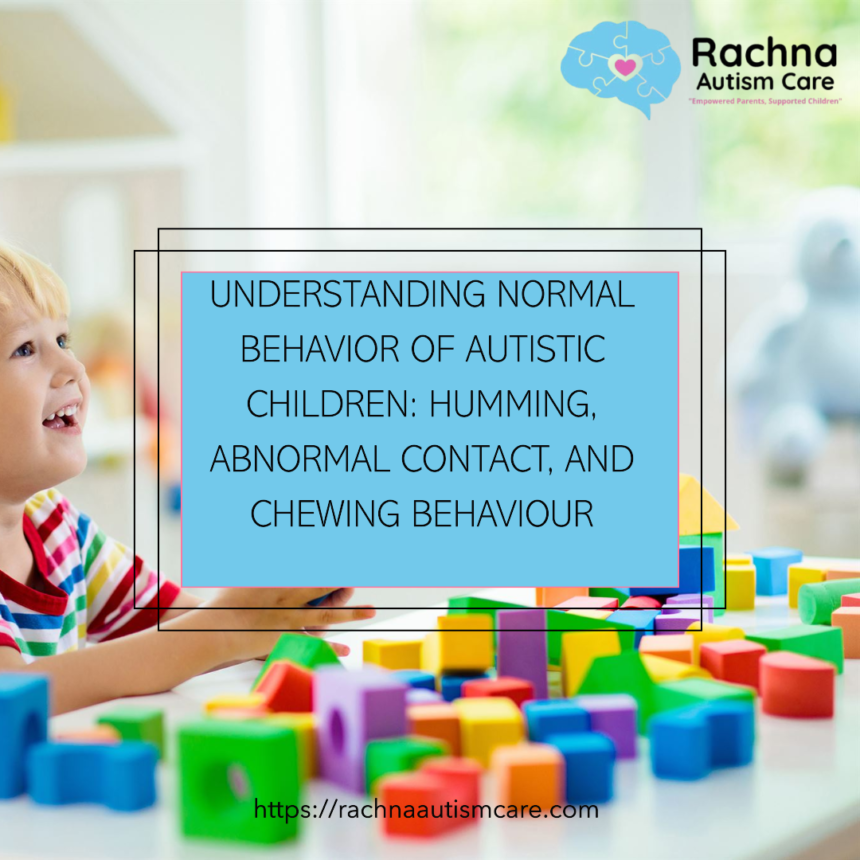Understanding Autistic Behaviors: Humming, Eye Contact Challenges, and Chewing in Kids
Parent of a child on the autism spectrum: You must have noticed some strange behaviors from your child. Those behaviors tend to seem mysterious and somewhat difficult at the outset. Three common behaviors found among children on the autism spectrum are humming, lack of eye contact, and chewing. The better we understand these behaviors, the better we can support our children and create a nurturing environment that encourages their growth and development.
Autistic Children and Humming
You’ve probably noticed that your autistic children humming repeatedly, especially during times they seem stressed or overwhelmed. This is very normal in autistic children. It serves to do a few things: very important.
- Self-soothing: It is just a way to calm oneself; it helps children regulate their emotions and then cope much better with sensory overload.
- Focus aid: Some children use humming to concentrate better on tasks or block out distracting noises in the environment.
- Vibratory stimulation: The vibration produced by humming can be a source of nice, pleasurable sensory experience to certain autistic children.
- Communication: Humming in some instances can serve as a child’s method of communicating themselves or the world around them to the environment around them.
Humming is harmless in most situations but can be a good opportunity to refer to a few scenarios where it may become problematic. You can support your child:
To create a “humming corner” in the home so that the child can hum to his /her heart’s content
Help the child know when and when not to hum
Have some alternative sensory tools like fidget toys or noise-canceling headphones available.
Eye Contact
Many autistic children have a very hard time establishing and maintaining eye contact for autism kids, which can be distressing to parents who are used to more neurotypical standards. On the other hand, it’s extremely important to note that that difficulty is not due to a lack of interest or an absence of affection. Here are some reasons why this proves challenging:
- Sensory overload: For some autistic individuals, direct eye contact can be overwhelming and discomforting or even anxiety-provoking.
- Processing differences: Some children would find it hard to process the visual information together with verbal cues simultaneously.
- Alternative focus: For autistic kids, there is a preference for focusing on other parts of the face and even other parts of the body as a means of getting social information.
- Cultural differences: It is also worthy to note that there exists cultural variation regarding eye contact norms, and what is acceptable varies.
Help your child if they show difficulties with eye contact:
Recommends
Avoid forcing eye contact which may be stressful and anxiety-provoking
Promote “face-looking” rather than direct eye contact
Use objects of interest or visual supports to make interaction easier
Gradually encourage eye contact through games or role-playing if your child is tolerant of this.
Chewing Behavior of Autistic Children
Most autistic children exhibit the very common behavior Chewing Behaviors in Autistic Kids on non-food items, such as clothes, toys, and even their hands. This behavior is often called “stimming” or self-stimulatory behavior. The purposes of this behavior are several.
- Sensory seeking: Chewing is a strong source of sensory input, which can be calming and stimulating to the child.
- Anxiolytic: Some children chew when they are anxious or otherwise overwhelmed.
- Oral motor activity: In certain situations, chewing may exercise the oral muscles or even gratify an oral fixation.
- Sensory exploration: Children less than school age will often chew as a way to gain control over their environment.
Although chewing is so common and harmless in many cases, it always raises important issues involving safety as well as promotion of some alternative appropriate behaviors; therefore, some response is in order:
Some of the recommendations may entail:
Provide safe, specially designed chew toys or jewelry made for this purpose
Offer crunchy or chewy snacks as a substitute for non-food items
Teach your child when and where it is acceptable to use their chewing tools
Consult with an occupational therapist on more strategies and exercises
It is, therefore, also important to come first to the behaviors with an understanding and patience. Remember again that your child is not trying to be stubborn; he or she just processes the world differently.
Knowledge that is acquired and a more open attitude to such behaviors will give us the chance to be facilitators of an accepting supportive environment for more autistic children. Each child is unique, and every strategy applied may not be effective for the next. Therefore, if you would want tailored advice and approaches, do not be reluctant to ask healthcare providers, therapists, or support groups.
As we grow with our children, as we learn with them through challenges and discovery, so is the world of neurodiversity: where strength in unique ways is valued along with challenges and issues. Your love, support, and understanding are, however, the most powerful tools to help that child to thrive and to reach their full potential.


